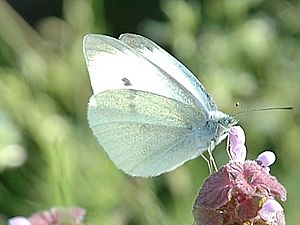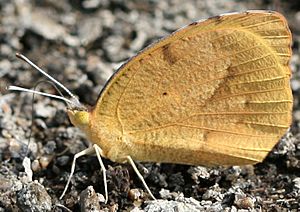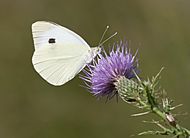Pieridae facts for kids
Quick facts for kids Pieridae |
|
|---|---|
 |
|
| The Small White or Cabbage White (Pieris rapae) | |
| Scientific classification | |
| Kingdom: | |
| Phylum: | |
| Class: | |
| Order: | |
| Suborder: | |
| Superfamily: | |
| Family: |
Pieridae
Duponchel, 1835
|
| Subfamilies | |
|
Dismorphiinae |
|
| Diversity | |
| 76 genera 1,051 species |
|

The Pieridae are a large family of butterflies. They are often called Whites, Yellows, or Sulphurs. This family includes about 76 different groups (genera) and 1,100 species. Most of them live in tropical Africa and Asia.
Most Pierid butterflies are white, yellow, or orange. They usually have black spots or markings. The bright colors come from special pigments. These pigments are made from waste products inside the butterfly's body. This is a unique feature of this butterfly family.
Some people believe the name "butterfly" came from a member of this family. The Brimstone butterfly (Gonepteryx rhamni) was called the "butter-coloured fly" by early British naturalists.
Male and female butterflies in this family often look different. Their patterns or the number of black markings can vary between the sexes.
The caterpillars of some Pierid species eat brassica plants. These include plants like cabbage and broccoli. For example, the caterpillars of the Pieris brassicae and Pieris rapae are common in gardens. They can sometimes be agricultural pests.
Males of many Pierid species gather in groups to drink salts from moist soil. This behavior is called mud-puddling or puddling. They do this to get important nutrients.
Contents
What Makes Them Special?
Pieridae butterflies have front legs that are well-developed in both males and females. Their claws are split into two parts, which is called bifid.
Like Swallowtail butterflies, Pieridae also have their chrysalids held at an angle. A silk thread, called a girdle, holds the chrysalis in place. This girdle goes around the first part of the chrysalis's body.
Subfamilies of Pieridae
The Pieridae family is divided into four main groups, called subfamilies:
Dismorphiinae
- This group has 6 genera.
- Most of them live in the Neotropical regions (Central and South America).
- Many species in this group are mimics. This means they look like other, often dangerous, species to protect themselves.
- Their caterpillars eat plants from the Fabaceae family (like peas and beans).
Pierinae
- This is a large group with 55 genera.
- It includes the butterflies known as Whites and Orange-tips.
- Many species in this subfamily travel long distances. They are strongly migratory.
- Their caterpillars feed on plants from families like Capparidaceae, Brassicaceae (cabbage family), Santalaceae, and Loranthaceae.
Coliadinae
- This subfamily has 14 genera.
- It includes the Sulphurs and Yellows.
- Many species show sexual dimorphism. This means males and females look very different from each other.
- Some species, like those in the Colias group, have wing patterns that you can only see under ultraviolet light.
Pseudopontiinae
- This subfamily has only one main species, Pseudopontia paradoxa.
- It is found only in West Africa. This means it is endemic to that region.
Some Popular Pieridae Species
- Anthocharis cethura catalina, known as the Catalina Orangetip.
- Anthocharis cardamines, called the Orange Tip.
- Colias croceus, the Clouded Yellow.
- Colias eurydice or Zerene eurydice, known as the California Dogface.
- Gonepteryx rhamni, the Brimstone butterfly.
- Leptosia nina, the Psyche butterfly.
- Phoebis sennae, the Cloudless Sulphur.
Some Pieridae Pest Species

- Colias eurytheme, also called the Alfalfa butterfly or Orange Sulphur.
- Colias philodice, known as the Clouded Sulphur or Common Sulphur.
- Pieris rapae, the Cabbage White or Small White.
- Pieris brassicae, the Large White or Cabbage White.
Images for kids
-
Sleepy oranges mud-puddling on a damp spot, Stuckey, South Carolina
See also
 In Spanish: Piéridos para niños
In Spanish: Piéridos para niños




